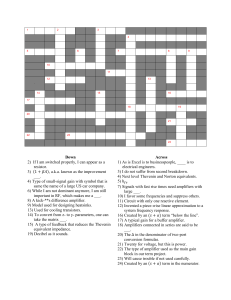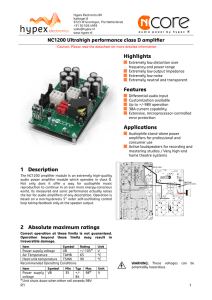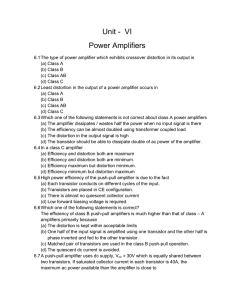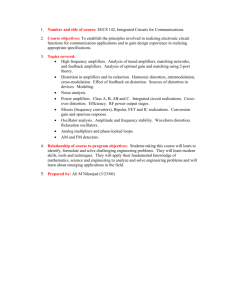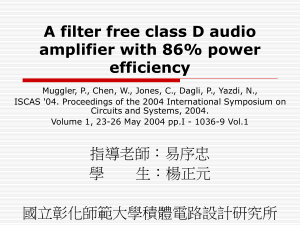Single-Ended Class A Amplifier Design Principles & Audio Quality
advertisement
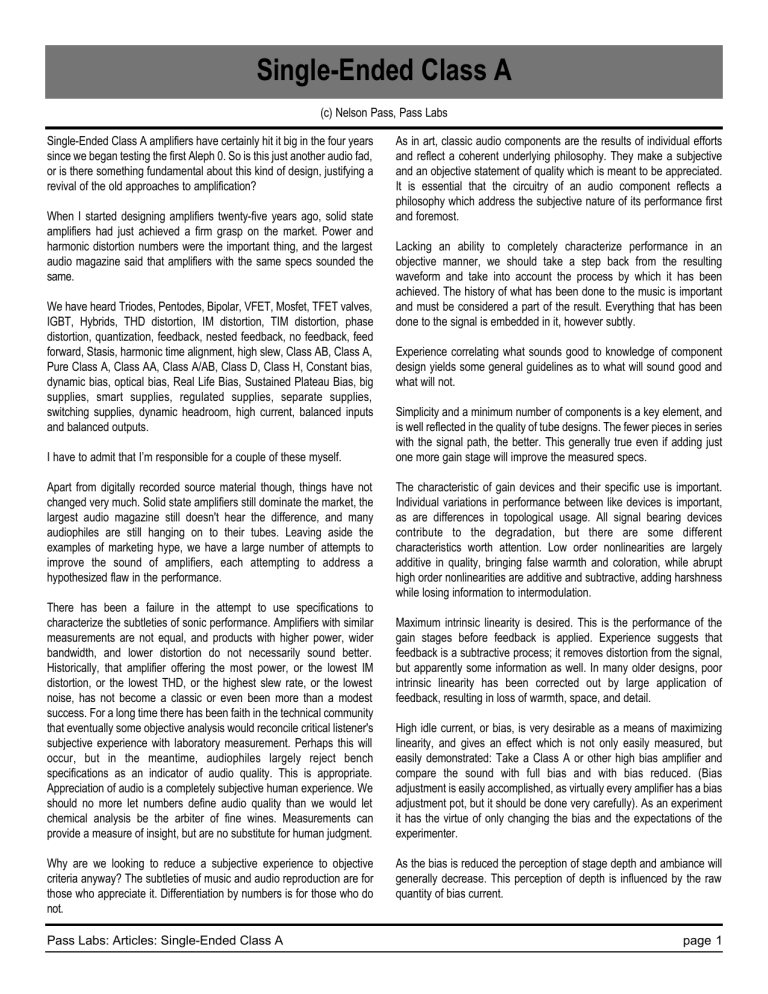
Single-Ended Class A (c) Nelson Pass, Pass Labs Single-Ended Class A amplifiers have certainly hit it big in the four years since we began testing the first Aleph 0. So is this just another audio fad, or is there something fundamental about this kind of design, justifying a revival of the old approaches to amplification? When I started designing amplifiers twenty-five years ago, solid state amplifiers had just achieved a firm grasp on the market. Power and harmonic distortion numbers were the important thing, and the largest audio magazine said that amplifiers with the same specs sounded the same. We have heard Triodes, Pentodes, Bipolar, VFET, Mosfet, TFET valves, IGBT, Hybrids, THD distortion, IM distortion, TIM distortion, phase distortion, quantization, feedback, nested feedback, no feedback, feed forward, Stasis, harmonic time alignment, high slew, Class AB, Class A, Pure Class A, Class AA, Class A/AB, Class D, Class H, Constant bias, dynamic bias, optical bias, Real Life Bias, Sustained Plateau Bias, big supplies, smart supplies, regulated supplies, separate supplies, switching supplies, dynamic headroom, high current, balanced inputs and balanced outputs. I have to admit that I’m responsible for a couple of these myself. Apart from digitally recorded source material though, things have not changed very much. Solid state amplifiers still dominate the market, the largest audio magazine still doesn't hear the difference, and many audiophiles are still hanging on to their tubes. Leaving aside the examples of marketing hype, we have a large number of attempts to improve the sound of amplifiers, each attempting to address a hypothesized flaw in the performance. There has been a failure in the attempt to use specifications to characterize the subtleties of sonic performance. Amplifiers with similar measurements are not equal, and products with higher power, wider bandwidth, and lower distortion do not necessarily sound better. Historically, that amplifier offering the most power, or the lowest IM distortion, or the lowest THD, or the highest slew rate, or the lowest noise, has not become a classic or even been more than a modest success. For a long time there has been faith in the technical community that eventually some objective analysis would reconcile critical listener's subjective experience with laboratory measurement. Perhaps this will occur, but in the meantime, audiophiles largely reject bench specifications as an indicator of audio quality. This is appropriate. Appreciation of audio is a completely subjective human experience. We should no more let numbers define audio quality than we would let chemical analysis be the arbiter of fine wines. Measurements can provide a measure of insight, but are no substitute for human judgment. Why are we looking to reduce a subjective experience to objective criteria anyway? The subtleties of music and audio reproduction are for those who appreciate it. Differentiation by numbers is for those who do not. Pass Labs: Articles: Single-Ended Class A As in art, classic audio components are the results of individual efforts and reflect a coherent underlying philosophy. They make a subjective and an objective statement of quality which is meant to be appreciated. It is essential that the circuitry of an audio component reflects a philosophy which address the subjective nature of its performance first and foremost. Lacking an ability to completely characterize performance in an objective manner, we should take a step back from the resulting waveform and take into account the process by which it has been achieved. The history of what has been done to the music is important and must be considered a part of the result. Everything that has been done to the signal is embedded in it, however subtly. Experience correlating what sounds good to knowledge of component design yields some general guidelines as to what will sound good and what will not. Simplicity and a minimum number of components is a key element, and is well reflected in the quality of tube designs. The fewer pieces in series with the signal path, the better. This generally true even if adding just one more gain stage will improve the measured specs. The characteristic of gain devices and their specific use is important. Individual variations in performance between like devices is important, as are differences in topological usage. All signal bearing devices contribute to the degradation, but there are some different characteristics worth attention. Low order nonlinearities are largely additive in quality, bringing false warmth and coloration, while abrupt high order nonlinearities are additive and subtractive, adding harshness while losing information to intermodulation. Maximum intrinsic linearity is desired. This is the performance of the gain stages before feedback is applied. Experience suggests that feedback is a subtractive process; it removes distortion from the signal, but apparently some information as well. In many older designs, poor intrinsic linearity has been corrected out by large application of feedback, resulting in loss of warmth, space, and detail. High idle current, or bias, is very desirable as a means of maximizing linearity, and gives an effect which is not only easily measured, but easily demonstrated: Take a Class A or other high bias amplifier and compare the sound with full bias and with bias reduced. (Bias adjustment is easily accomplished, as virtually every amplifier has a bias adjustment pot, but it should be done very carefully). As an experiment it has the virtue of only changing the bias and the expectations of the experimenter. As the bias is reduced the perception of stage depth and ambiance will generally decrease. This perception of depth is influenced by the raw quantity of bias current. page 1 If you continue to increase the bias current far beyond the operating point, it appears that improvements are made with bias currents which are much greater than the signal level. Typically the levels involved in most critical listening are only a few watts, but an amplifier biased for ten times that amount will generally sound better than one biased for the few watts. For this reason, designs which operate in what has been referred to as "pure" Class A are preferred because their bias currents are much larger than the signal most of the time. As mentioned, preamp gain stages and the front ends of power amplifiers are routinely single-ended "pure" Class A, and because the signal levels are at small fractions of a watt, the efficiency of the circuit is not important. The "purity" of Class A designs has been at issue in the last few years, with "pure" Class A being loosely defined as an idling heat dissipation of more than twice the maximum amplifier output. For a 100 watt amplifier, this would be 200 watts out of the wall on a constant basis. Designs which vary the bias against the musical signal will generally have bias currents at or below the signal level. This is certainly an improvement from the viewpoint of energy efficiency, but the sound reflects the lesser bias point. Given the assumption that every process that we perform on the signal will be heard, the finest amplifiers must employ those processes which are most natural. There is one element in the chain which we cannot alter or improve upon, and that is the air. Air defines sound, and serves as a natural benchmark. Virtually all the amplifiers on the market are based on a push-pull symmetry model. The push-pull symmetry topology has no particular basis in nature. Is it valid to use air's characteristic as a model for designing an amplifier? If you accept that all processing leaves its signature on the music, the answer is yes. One of the most interesting characteristics of air is its single-ended nature. Sound traveling through air is the result of the gas equation: PV1.4 = 1.26 X 104 where P is pressure and V is volume. The small nonlinearity which is the result of air's characteristic is not generally judged to be significant at normal sound levels, and is comparable to the distortion numbers of fine amplifiers. This distortion generally only becomes a concern in the throats of horns, where the intense pressure levels are many times those at the mouth, and where the harmonic component can reach several per cent. We can push on air and raise the pressure an arbitrary amount, but we cannot pull on it. We can only let it relax and fill a space as it will, and the pressure will never go below "0". As we push on air, the increase in pressure is greater than the corresponding decrease when we allow air to expand. This means that for a given motion of a diaphragm acting on Pass Labs: Articles: Single-Ended Class A air, the positive pressure perturbations will be slightly greater than the negative. From this we see that air is phase sensitive. As a result of its single-ended nature, the harmonic content of air is primarily 2nd order, and most of the distortion of a single tone is second harmonic. Air's distortion characteristic is monotonic, which is to say its distortion products decrease smoothly as the acoustic level decreases. This is an important element which has often been overlooked in audio design and is reflected in the poor quality of early solid state amplifiers and D/A and A/D converters. They are not monotonic: the distortion increases as the level decreases. The usual electrical picture of an audio signal is as an AC waveform, without a DC component. Audio is represented as alternating voltage and current, where positive voltage and current alternates with negative in a reciprocal and symmetric fashion. This fiction is convenient because it lends itself to the use of an energy efficient design for amplifier power stages known as push-pull, where a "plus" side of an amplifier alternates operation with a "minus" side. Each side of a push-pull amplifier handles the audio signal alternately; the "plus" side supplying positive voltage and current to the loudspeaker, and the "minus" side supplying negative voltage and current. Problems with push-pull amplifier designs associated with crossover distortion have been discussed elsewhere at length, and one of the primary results is non-monotonicity. Class B and many AB designs have distortion products which dramatically increase with decreasing signal. This is reduced greatly by Class A mode, but crossover distortion remains as a lower order discontinuity in the transfer curve. For reproducing music as naturally as possible, push-pull symmetric operation is not the best approach. Air is not symmetric and does not have a push-pull characteristic. Sound in air is a perturbation around a positive pressure point. There is only positive pressure, more positive pressure, and less positive pressure. Descriptions of push-pull often illustrate this type of operation with a picture of two men sawing a tree by hand, one on each side of the saw. Certainly this is an efficient way to cut down trees, but can you imagine two men playing a violin? An analogy using a violin or similar stringed instrument illustrates singleended operation nicely and points out the control and finesse which can be achieved when only one gain device controls the performance of a gain stage. By contrast, push pull Class A circuits have two opposing gain devices producing the output signal, and though it is industrially effective and efficient, it is not the most delicate way to amplify a signal. Push-pull circuits give rise to odd ordered harmonics, where the phase alignment reflects compression at both positive and negative peaks and crossover nonlinearity near the zero point. Only one linear circuit topology delivers the appropriate characteristic, and that is the single- ended amplifier. Single ended amplification only comes in pure Class A, and is the least efficient form of power stage you can reasonably create, typically idling between three and five times the page 2 rated output power. Single-ended operation is not new. It is routinely found in the low level circuitry of the finest preamplifying stages and in the front end circuits of the finest power amplifiers. The first tube power amplifiers were singleended circuits using a single tube driving the primary of a transformer. In 1977 I designed and published in Audio Magazine a single-ended Class A amplifier using bipolar followers biased by a constant current source. A considerable number of amateurs have built the device, rated at 20 watts output, and many have commented on its unique sonic signature. It is one of the very few examples of a solid state singleended output stage available. Single-ended Class A operation is less efficient than push-pull. Singleended amplifiers tend to be bigger and more expensive than push-pull, but they have a more natural transfer curve. A very important consideration in attempting to create an amplifier with a natural characteristic is the selection of the gain devices. A singleended Class A topology is appropriate, and we want a characteristic where the positive amplitude is very, very slightly greater than the negative. For a current gain device, that would mean gain which smoothly increases with current, and for a tube or field effect device a transconductance which smoothly increases with current. Triodes and Mosfets share a useful characteristic: their transconductance tends to increase with current. Bipolar power devices have a slight gain increase until they hit about an amp or so, and then they decline at higher currents. In general the use of bipolar in a singleended circuit is a poor fit. Another performance advantage shared by Tubes and Fets is the high performance they deliver in simple Class A circuits. Bipolar designs on the market have between four and seven gain stages associated with the signal path, but with tubes and Mosfets good objective specifications are achievable with only 2 or 3 gain devices in the signal path. Yet a third advantage tubes and Mosfets have over bipolar devices is their greater reliability at higher temperatures. Single-ended power amplifiers dissipate comparatively high wattages and run hot. In a decision between Triodes and Mosfets, the Mosfet's advantage is in naturally operating at the voltages and currents we want to deliver to a loudspeaker. Efforts to create a direct coupled single-ended triode power amplifier have been severely limited by the high voltages and low plate currents that are the province of tubes. Power Mosfets have an interesting character in that they have relatively high distortion until you run quite a large amount of current through them. This makes them very suitable for pure Class A operation, particularly single-ended. It also makes them far less suitable for Class B and AB operation where they become quite non-linear near their cutoff point, and require a large amount of negative feedback correction to deliver clean output. lower transconductance and higher intrinsic resistance and distortion than the newer generations. They also were rather anemic in terms of their current, voltage, and wattage ratings. On top of that, looking at the schematics of early and even contemporary Mosfet amplifier designs, we see that they usually have been simply dropped in as replacements for bipolar devices in Class B and AB designs, without regard for their particular linearity requirements, and without taking advantage of their unique characteristics. Given the Mosfet characteristic, it is easy to understand why early and even contemporary amplifiers using them have not achieved the measure of sonic performance that the devices seemed to offer. The promise of the transconductance characteristic in power amplifiers in providing the most realistic amplified representation of music is best fulfilled by Mosfets in single-ended Class A circuitry where it they be used very simply and biased to very high currents. Last year I published a single-ended Class A power amplifier design in The Audio Amateur Magazine. It employs only one gain stage for the entire amplifier. Called the Zen amplifier (after all, what is the sound of one transistor clapping?) it illustrates the extremes of simplicity that can be achieved with Mosfets operated in single-ended Class A and high objective and subjective performance. More information on the Zen amplifier and its successor, the Son of Zen, is available from The Audio Amateur. As yet, very few other single-ended solid state amplifiers are available on the market. This will change as the demand continues to increase and as other designers learn how to build them. In the meantime, transformer coupled single-ended triode amplifiers are the alternative, using very large gapped-core transformers to avoid core saturation from the high DC current. These designs reflect more traditional thinking in single-ended amplification. They suffer the characteristic of a loosely coupled transformer, more limited wattage, and higher measured distortion than their solid state counterparts, however they still set the standard for midrange lucidity, and are not to be dismissed. Besides being easier to use, the primary advantage of Mosfets over tubes is that they operate at voltages and currents appropriate to loudspeakers without conversion, and do not require an output transformer. Regardless of the type of gain device, in systems where the utmost in natural reproduction is the goal, simple single-ended Class A circuits are the topologies of choice. Not all power Mosfets are the same, either. The early Mosfets had much Pass Labs: Articles: Single-Ended Class A page 3
